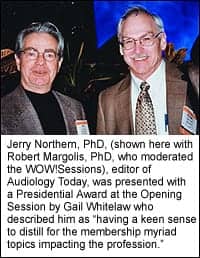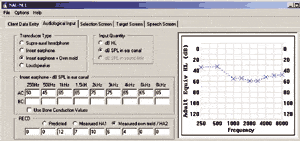HARC Mercantile offers a “cornucopia” of products for individuals with hearing loss. Hearing Products Report interviewed Ron D. Slager, CEO of HARC’s parent company HAC-Hearing Aid Centers of America Inc, about the company’s offerings, as well as its start and continuation as a family-run business.

A: In 1960, my father, Robert Slager, started in the hearing aid business as a then-traditional single-line hearing aid dealership and, over the years, expanded to become a multi-line dealer. He and my mother, Ruth, worked together with other staff over the years, operating a strong, yet typical mom-and-pop hearing aid business.
In 1974, I joined the business to launch a revolutionary hearing aid distribution concept named the Hearing Aid Center (HAC) of Kalamazoo, an alternative dispensing service. HAC of Kalamazoo began dispensing hearing aids on the specific make/model recommendations of audiologists in a variety of settings, who, at that time, were not selling hearing aids because of professional ethics and restrictive licensing, etc. The HAC Alternative offered them the opportunity to select and fit hearing aids without being involved in the actual sale as the client purchased their hearing aid directly from HAC at what was then a wholesale-type price. That dispensing model was strong for more than 20 years and still is being used in some areas today. However, as audiologists began to dispense, the volume for that division of the business has declined.
HARC Mercantile Ltd, our assistive device dispensing operation, evolved out of the dust and insights along the way as we observed the inadequacy of hearing aids in solving many of the more specific communicative needs of our clients. So we began offering more and more products through our full-service operation and hearing aid distribution until we decided to segregate its operation and officially launched HARC Mercantile with its own identity in 1980.
Q: What does the name HARC stand for?
A: That is a question we get asked all the time. The answer simply is: HARC stands for HARC—it is the name and nothing more. When we made the decision to set up a separate assistive listening device (ALD) company, the dilemma was “What do we call this new division?” We knew we didn’t want to reference hearing aids in the name at all, and we wanted the name to reflect the vast selection of products offered.
We thought of the old general store or mercantile that had a little bit of everything to offer their customers, so the “Mercantile” part was easy. HARC was somehow derived from doodles on a legal pad, I think, and jokes about “Hark!” When all was said and done, it just stuck. Over the years, there hasn’t been a week or hardly a day that goes by when someone hasn’t just had to ask the question, “By the way, what does HARC stand for?” And we have to say, “It stands for quality, service, and value. It means having a quality solution that’s right for your particular hearing loss and need, at an affordable price. No more and no less!”
Q: Are there other family members still involved with the company?
A: My mother passed away in 1984, but my father, though retired, still maintains an office with semiregular hours at age 82. My wife, Jo, is also highly involved in the daily operations of the business.
Q: What are the most popular ALDs you sell?
A: If I had to point to any one type of product that we get the most calls about, I would have to say telephones. The personal communicators would be a close second.
Q: Are there any items that are “tough sells” in the hearing health care field, either to the end users or to the professionals in the field?
A: The toughest sale in the ALD business is to convince the dispensers—whether they are traditional dealers or dispensing audiologists—that they have a moral obligation to their clients to have, show, and provide ALDs.
They have to admit that the hearing aid, no matter how great and how sophisticated it may be, is not [the be-all] and end-all solution for their clients because there are just times when a hard-of-hearing client/hearing-aid wearer needs more than the hearing aid can offer, or there are times when they aren’t wearing the hearing aid and still need to be “plugged in” to the world around them. And just because there are not the same lucrative margins in ALDs as there are in hearing aids, they are just as important—and in the case of life safety devices, such as visual smoke detectors, more important.
Q: How much of the company is now devoted to mail order distribution versus in-store purchases?
A: HARC maintains about a 1,200-square-foot interactive ALD showroom in our corporate office facility. The facility also houses our flagship Hearing Center operation, where smaller display areas are found in the client waiting areas, and our audiological staff has FM and inductive products in each of the fitting and consulting areas to show clients as well. About a third of HARC’s revenue comes from these retail areas, and we have [some] clients [who] travel more than 200 miles to browse and try products on a regular basis.
Q: Are audiologists and hearing aid dispensers today knowledgeable enough and helpful enough to their patients about the assistive devices that are available?
A: Audiologists and hearing aid dispensers are knowledgeable enough about ALDs—after all, it isn’t rocket science. Frankly, the number one excuse we get from audiologists and dispensers when asked why they aren’t selling ALDs is “There isn’t enough money in it for me to bother!”
Q: How have today’s consumer devices affected the look and acceptance of assistive listening devices among individuals who are deaf or hard-of-hearing?
A: Fortunately for the consumer who is hard of hearing, more and more “consumer products” are being manufactured with universal design in mind, so special features that in the past were perhaps for the hard of hearing only are being incorporated into the regular, off-the-shelf products. However, there are a number of products that will never be incorporated into regular retail products.
Q: What is the role of HARC Mercantile’s corporate parent, the HAC of America Group?
A: The HAC of America Group owns and operates all the aspects of our company, which includes HARC Mercantile Ltd’s retail and mail order operations; HARC wholesale operations; HARC ADA (American with Disabilities Act) compliance and consulting operations; HAC-Hearing Aid Center of Kalamazoo’s alternative hearing dispensing operations; HID-Hearing Instruments Distributors wholesale hearing aid sale; and the Hearing Center of Kalamazoo professional audiology and retail hearing aid sales locations in Michigan.
Q: What is included in your Accessolutions product line?
A: The Accessolutions product line is a collection of select assistive devices that we feel are the best of the best products available for our market. We offer an assortment of life safety devices, such as Michigan manufacturer Gentex’s Visual Smoke Detectors; alerting and signaling devices also made by Michigan companies Silent Call and Sonic Alert; visual and tactile alarm clocks and watches; and infrared listening systems by Enhanced Listening Technologies. We import induction loop systems from Europe’s Hearing Products International. We offer Phonak FM products and are a wireless technology center for them. We are a master distributor for Clarity Products and Williams Sound. A growing area of interest is cell phone and Bluetooth® interfacing products. We have quite a section of books and videos, as well as hard-of-hearing and deaf-related novelty products. We also have hearing aid batteries and maintenance products.
Yes, a literal cornucopia of products for the hard of hearing and deaf, selected with the ultimate purpose being to improve the quality of life for those faced with those disabilities.
Q: What was the vision for the Hearing Aid Center of Kalamazoo?
A: In 1974, when my father and I were discussing the shortcomings and future of the hearing aid industry, we decided to do our own market study to see what the consumer and professional markets thought about the industry, as it was at that point in time.
What we found was interesting: Basically, there were three professional segments, which neither cared for, worked well with, nor trusted each other. They were the medical profession, the audiological profession, and the traditional hearing aid dealers. The consumer considered hearing aid dealers pitchmen, a la vacuum cleaner sales types, with overpriced, overrepresented products. They never heard of an audiologist and only went to the doctor if [something] really hurt, but tended to think that doctors knew everything.
So, here were these three spheres of professional influences not working with each other and clients—or potential clients—entering the market at these three points, not getting refereed to the next level.
After digesting all that information, we strategically set out to design a system to bridge some of the professional gaps and provide a cost-effective, user-friendly approach to provide amplification to the end user who was hard of hearing. Thus, the HAC-Hearing Aid Center of Kalamazoo Alternative Hearing Aid Dispensing Plan. The alternative plan, as we called the operation, would serve as an audiologist’s or speech and hearing center’s dispensing service. The audiologist would provide only the professional services, and we would vend the “hardware”—hearing aids, earmolds, batteries, and repair services—to the clients. We electro-acoustically tested every hearing aid ourselves because manufacturers didn’t do it at that time. And we also required medical approval from a doctor, preferably an ENT (before it was required by the Food and Drug Administration). This concept was revolutionary, and it opened up the world of hearing aid fitting to the audiological profession that for the most part, at that time, was primarily doing diagnostics and little or no fitting.
Q: Has that original focus for the HAC of Kalamazoo changed at all over the years?
A: Over the years, we watched those audiologists who started with our alternative program one by one enter the direct dispensing field. Even though today we have a fair number of clinics still using that service, the number is nowhere near where it was in the late 1980s. So, our focus went more to ALDs and commercial ADA compliance, and we renewed emphasis on our own professional and retail hearing operations. Now we are embarking on the launch of our own retail full-service locations with not only audiological services and hearing aids but ALDs and custom earware as well.
We feel the next 10 years will see a greater need for hearing health care providers to be more than dispensers and fitters of hearing aids, but “total communications resource centers.”
Q: In the same way that Bluetooth devices have changed people’s perception of assistive listening products, do you foresee anything else in the consumer market affecting that perception—and ultimately, better acceptance—in the future?
A: I see more and more integration of technologies from the consumer side, such as Bluetooth, with ALDs and/or the hearing aid itself. We see our company again as a bridge to bring these markets together, and as such, we feel the consumer will be the big winner.
Ron Slager can be reached at HARC Mercantile at (800) 445-9968 or [email protected].





